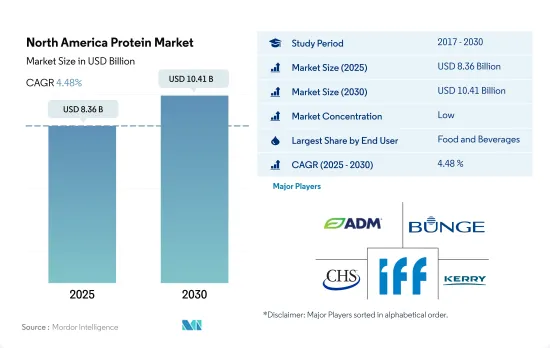Need help finding what you are looking for?
Contact Us
PUBLISHER: Mordor Intelligence | PRODUCT CODE: 1690964

PUBLISHER: Mordor Intelligence | PRODUCT CODE: 1690964
North America Protein - Market Share Analysis, Industry Trends & Statistics, Growth Forecasts (2025 - 2030)
PUBLISHED:
PAGES: 335 Pages
DELIVERY TIME: 2-3 business days
SELECT AN OPTION
The North America Protein Market size is estimated at 8.36 billion USD in 2025, and is expected to reach 10.41 billion USD by 2030, growing at a CAGR of 4.48% during the forecast period (2025-2030).

The food and beverage segment dominates due to a strong demand from the dairy and dairy alternatives and supplements sub-segments
- The food and beverage segment dominates the market due to the growing need for whey, wheat, and pea proteins in food and beverage products. Due to the extensive use of soy-based plant protein, the dairy and meat alternatives sub-segments continued to hold leading positions. Together, the two sub-segments made up around 60% of the total volume of the food and beverage segment in the region in 2022. Since soy can replicate muscle texture when stacked into linear fibers, soy protein leads the protein market. Due to this property, it is highly used for high-moisture extrusion, gelling, and protein fortification. To produce the requisite anisotropic product structure, these meat analogs are extruded at high moisture contents (>40%) and elevated temperatures above 100 °C.
- Animal feed is the second-largest segment due to the expansion of livestock production and the adoption of advanced animal nutrition technologies. The market potential for animal feed is further expanded by the introduction of sustainable alternative protein sources like insect protein. In 2022, North America held the highest share in the global compound feed production, i.e., approximately 261 million ton and a share of 20.6%.
- Personal care and cosmetics is the fastest-growing segment, and it is projected to register a CAGR of 6.42% by value during 2024-2029. In the United States, 6.8 million people suffer from hair problems such as alopecia areata. Collagen peptides, which are the hydrolyzed form of collagen, nourish the hair bulbs and strengthen the hair follicles by fostering the ideal conditions for healthy hair growth. OGX Biotin & Collagen Shampoo, Salcoll Collagen Hair Mist, Hair La Vie Foundation Collagen Elixir, etc., are a few examples of hair care products containing collagen.
The United States holds a majority share of the market due to the strong presence of various food manufacturing units
- The North American protein market witnessed a favorable growth rate of 10.49% in terms of sales value from 2020 to 2023. The United States led the market due to high product consolidation and an active competitive landscape. Companies are strengthening their presence in the country by acquiring small firms, ramping up protein production units, and expanding their product portfolios. Companies such as Agropur, Anchor Ingredients, and Hilmar Cheese boosted their production capabilities over the review period. Thus, constant product developments and differentiation in the market further resulted in additional sales by volume.
- Canada remained the second-largest market in 2023, driven by consumers pushing for diversification of protein sources. Animal proteins are being replaced by new functional foods and value-added products that are created by the booming plant-protein industry. In 2021, more than 40% of people in Canada actively strived to increase their consumption of plant-based foods. The popularity of plant-based protein sources recently increased due to their suitability for vegetarian, vegan, and "flexitarian" lifestyles.
- Mexico is likely to be the fastest-growing market, with a projected volume CAGR of 6.31% from 2024 to 2029. The Mexican market is dominated by the demand for plant proteins in the country, and it is anticipated to register a CAGR of 6.51% by volume from 2024 to 2029. Due to the rising awareness among Mexican consumers about food safety, environmental sustainability, and animal welfare aspects of meat, a significant portion of the country observed a shift from animal protein products to plant-based protein products.
North America Protein Market Trends
The consumption growth of animal protein is fueling opportunities for key players in the ingredients segment
Meat and milk production contribute majorly as raw materials for animal protein ingredients
North America Protein Industry Overview
Additional Benefits:
Product Code: 90056
TABLE OF CONTENTS
1 EXECUTIVE SUMMARY & KEY FINDINGS
2 INTRODUCTION
- 2.1 Study Assumptions & Market Definition
- 2.2 Scope of the Study
- 2.3 Research Methodology
3 KEY INDUSTRY TRENDS
- 3.1 End User Market Volume
- 3.1.1 Baby Food and Infant Formula
- 3.1.2 Bakery
- 3.1.3 Beverages
4 MARKET SEGMENTATION (includes market size in Value in USD and Volume, Forecasts up to 2030 and analysis of growth prospects)
5 COMPETITIVE LANDSCAPE
6 KEY STRATEGIC QUESTIONS FOR PROTEIN INGREDIENTS INDUSTRY CEOS
7 APPENDIX
Have a question?


SELECT AN OPTION
Have a question?


Questions? Please give us a call or visit the contact form.
